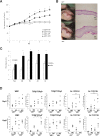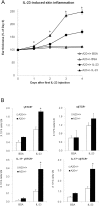Hypomorphic A20 expression confers susceptibility to psoriasis
- PMID: 28658319
- PMCID: PMC5489224
- DOI: 10.1371/journal.pone.0180481
Hypomorphic A20 expression confers susceptibility to psoriasis
Abstract
Psoriasis is a common inflammatory skin disease that affects approximately 1% of the population worldwide. Tumor necrosis factor-alpha-induced protein 3 (TNFAIP3) gene polymorphisms have been strongly associated with psoriasis susceptibility. In this study, we investigate how TNFAIP3, also known as A20, may regulate psoriasis susceptibility. We found that haplo-insufficient A20+/- mice develop severe toll-like receptor (TLR)-induced skin inflammation compared to wild type mice owing to amplified production of interleukin (IL)-17 and IL-23. Examination of TNFAIP3 mRNA expression in skin biopsies from patients with psoriasis revealed reduced expression in both involved and uninvolved skin. Our results demonstrate the clinical importance of reduced dermal expression of A20 in psoriasis and suggest that A20 restriction of the IL-23/17 axis protects against psoriasis.
Conflict of interest statement
Figures





Similar articles
-
Keratinocyte Expression of A20/TNFAIP3 Controls Skin Inflammation Associated with Atopic Dermatitis and Psoriasis.J Invest Dermatol. 2019 Jan;139(1):135-145. doi: 10.1016/j.jid.2018.06.191. Epub 2018 Aug 14. J Invest Dermatol. 2019. PMID: 30118730
-
TNF-α-induced protein 3 (TNFAIP3)/A20 acts as a master switch in TNF-α blockade-driven IL-17A expression.J Allergy Clin Immunol. 2018 Aug;142(2):517-529. doi: 10.1016/j.jaci.2017.11.024. Epub 2017 Dec 14. J Allergy Clin Immunol. 2018. PMID: 29248493
-
Ebosin Ameliorates Psoriasis-Like Inflammation of Mice via miR-155 Targeting tnfaip3 on IL-17 Pathway.Front Immunol. 2021 Apr 26;12:662362. doi: 10.3389/fimmu.2021.662362. eCollection 2021. Front Immunol. 2021. PMID: 33981308 Free PMC article.
-
Genetic relationships between A20/TNFAIP3, chronic inflammation and autoimmune disease.Biochem Soc Trans. 2011 Aug;39(4):1086-91. doi: 10.1042/BST0391086. Biochem Soc Trans. 2011. PMID: 21787353 Review.
-
Genetic variations in cytokines and cytokine receptors associated with psoriasis found by genome-wide association.J Invest Dermatol. 2009 Apr;129(4):827-33. doi: 10.1038/jid.2008.308. Epub 2008 Oct 2. J Invest Dermatol. 2009. PMID: 18830267 Review.
Cited by
-
NF-κB: At the Borders of Autoimmunity and Inflammation.Front Immunol. 2021 Aug 9;12:716469. doi: 10.3389/fimmu.2021.716469. eCollection 2021. Front Immunol. 2021. PMID: 34434197 Free PMC article. Review.
-
A20: A multifunctional tool for regulating immunity and preventing disease.Cell Immunol. 2019 Jun;340:103914. doi: 10.1016/j.cellimm.2019.04.002. Epub 2019 Apr 5. Cell Immunol. 2019. PMID: 31030956 Free PMC article. Review.
-
Tumour necrosis factor signalling in health and disease.F1000Res. 2019 Jan 28;8:F1000 Faculty Rev-111. doi: 10.12688/f1000research.17023.1. eCollection 2019. F1000Res. 2019. PMID: 30755793 Free PMC article. Review.
-
Non-catalytic ubiquitin binding by A20 prevents psoriatic arthritis-like disease and inflammation.Nat Immunol. 2020 Apr;21(4):422-433. doi: 10.1038/s41590-020-0634-4. Epub 2020 Mar 16. Nat Immunol. 2020. PMID: 32205880 Free PMC article.
-
Repressive Control of Keratinocyte Cytoplasmic Inflammatory Signaling.Int J Mol Sci. 2023 Jul 26;24(15):11943. doi: 10.3390/ijms241511943. Int J Mol Sci. 2023. PMID: 37569318 Free PMC article. Review.
References
-
- Nair RP, Duffin KC, Helms C, Ding J, Stuart PE, Goldgar D, et al. Genome-wide scan reveals association of psoriasis with IL-23 and NF-kappaB pathways. Nature genetics. 2009;41(2):199–204. Epub 2009/01/27. doi: 10.1038/ng.311 ; PubMed Central PMCID: PMC2745122. - DOI - PMC - PubMed
-
- Tejasvi T, Stuart PE, Chandran V, Voorhees JJ, Gladman DD, Rahman P, et al. TNFAIP3 gene polymorphisms are associated with response to TNF blockade in psoriasis. The Journal of investigative dermatology. 2012;132(3 Pt 1):593–600. Epub 2011/11/25. doi: 10.1038/jid.2011.376 ; PubMed Central PMCID: PMC3278539. - DOI - PMC - PubMed
-
- Opipari AW Jr., Boguski MS, Dixit VM. The A20 cDNA induced by tumor necrosis factor alpha encodes a novel type of zinc finger protein. The Journal of biological chemistry. 1990;265(25):14705–8. Epub 1990/09/05. . - PubMed
-
- Lee EG. Failure to Regulate TNF-Induced NF-kappa B and Cell Death Responses in A20- Deficient Mice. Science. 2000;289(5488):2350–4. doi: 10.1126/science.289.5488.2350 - DOI - PMC - PubMed
-
- Boone DL, Turer EE, Lee EG, Ahmad RC, Wheeler MT, Tsui C, et al. The ubiquitin-modifying enzyme A20 is required for termination of Toll-like receptor responses. Nature immunology. 2004;5(10):1052–60. Epub 2004/08/31. doi: 10.1038/ni1110 . - DOI - PubMed
MeSH terms
Substances
Grants and funding
LinkOut - more resources
Full Text Sources
Other Literature Sources
Medical
Molecular Biology Databases

